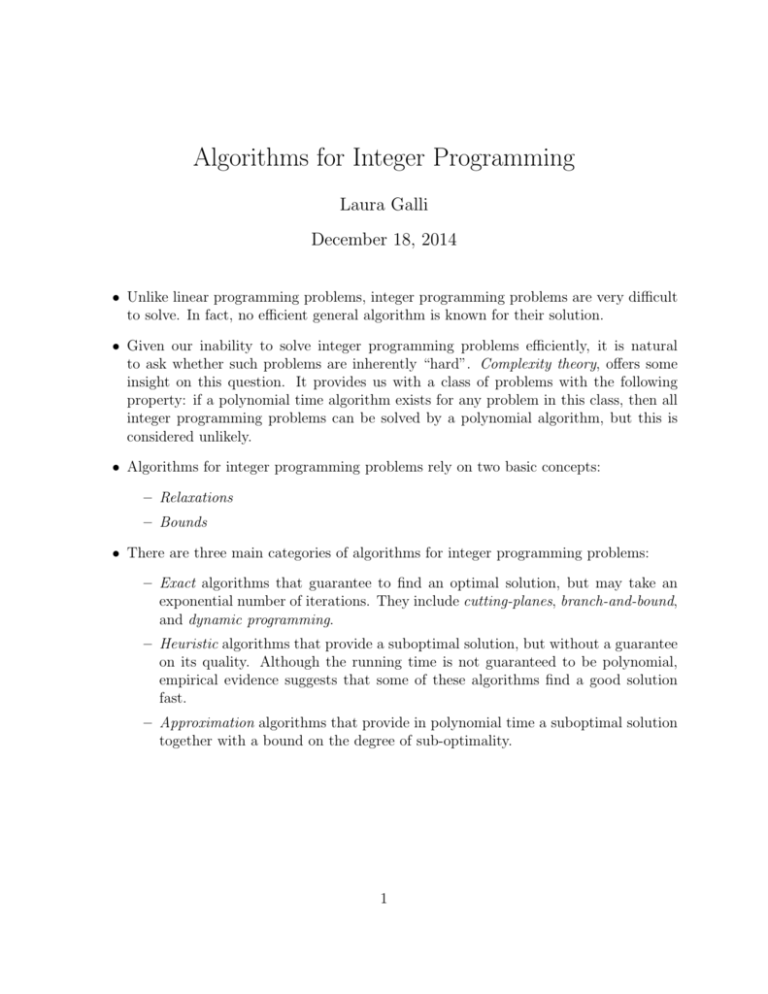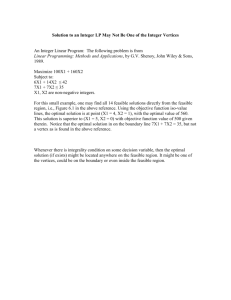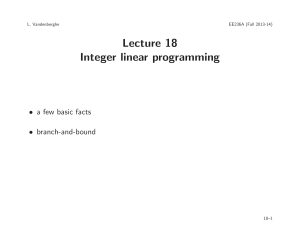Algorithms for Integer Programming
advertisement

Algorithms for Integer Programming
Laura Galli
December 18, 2014
• Unlike linear programming problems, integer programming problems are very difficult
to solve. In fact, no efficient general algorithm is known for their solution.
• Given our inability to solve integer programming problems efficiently, it is natural
to ask whether such problems are inherently “hard”. Complexity theory, offers some
insight on this question. It provides us with a class of problems with the following
property: if a polynomial time algorithm exists for any problem in this class, then all
integer programming problems can be solved by a polynomial algorithm, but this is
considered unlikely.
• Algorithms for integer programming problems rely on two basic concepts:
– Relaxations
– Bounds
• There are three main categories of algorithms for integer programming problems:
– Exact algorithms that guarantee to find an optimal solution, but may take an
exponential number of iterations. They include cutting-planes, branch-and-bound,
and dynamic programming.
– Heuristic algorithms that provide a suboptimal solution, but without a guarantee
on its quality. Although the running time is not guaranteed to be polynomial,
empirical evidence suggests that some of these algorithms find a good solution
fast.
– Approximation algorithms that provide in polynomial time a suboptimal solution
together with a bound on the degree of sub-optimality.
1
1
Optimality, Relaxation, and Bounds
• Given an IP max{cT x | x ∈ X ⊂ Zn+ }, how is it possible to prove that a given point
x∗ is optimal?
• Put differently, we are looking for some optimality conditions that will provide stopping
criteria in an algorithm for IP .
• The “naive” but nonetheless important reply is that we need to find a lower bound
z ≤ z and an upper bound z̄ ≥ z such that z = z = z̄.
• Practically, this means that any algorithm will find a decreasing sequence of upper
bounds, and an increasing sequence of lower bounds, and stop when z̄ − z ≤ .
• Primal bounds: every feasible solution x∗ provides a lower bound z = x∗ ≤ z .
• Dual bounds: The most important approach is by relaxation, the idea being to replace
a “difficult” (max) IP by a simpler optimization problem whose optimal value is at
least as large as z.
• For the relaxed problem to have this property, there are two obvious possibilities:
– Enlarge the set of feasible solutions so that one optimizes over a larger set, or
– Replace the (max) objective function by a function that has the same or a larger
value everywhere.
• Def.: A problem (RP ) z R = max{f (x) | x ∈ T ⊂ Rn } is a relaxation of (IP )
z = max{c(x) | x ∈ X ⊂ Rn } if:
1. X ⊆ T , and
2. f (x) ≥ c(x) ∀x ∈ X.
• If RP is a relaxation of IP =⇒ z R ≥ z.
• z R is an upper bound for z.
• The question then arises of how to construct interesting relaxations:
– Linear Programming relaxation: note that the definition of “better” formulation
is intimately related to that of linear programming relaxations. In particular,
better formulations give tighter (dual) bounds.
– Combinatorial relaxation: the relaxation is an “easy” combinatorial problem that
can be solved “rapidly”.
– Relaxation by elimination: suppose we are given an integer program IP in the
form z = max{c(x) | Ax ≤ b, x ∈ X ⊂ Rn }. If the problem is too difficult to
solve directly, one possibility is just to drop the constraints Ax ≤ b. Clearly, the
resulting problem z = max{c(x) | x ∈ X ⊂ Rn } is a relaxation of IP .
2
– Lagrangian relaxation: An important extension of this idea is not just to drop
complicating constraints, but then to add them into the objective function with
Lagrange multipliers (“penalizing” the violation). Let z(u) = max{c(x) + u(b −
Ax) | x ∈ X}. Then, z(u) ≥ z ∀u ≥ 0.
– Surrogate relaxation: A subset of constraints is substituted by a unique constraint
corresponding to their linear combination using a multiplier vector u ≥ 0: z(u) =
max{c(x) | uT (Ax) ≤ uT b, x ∈ X}.
2
Exact methods
2.1
Cutting-Planes
Given an integer programming problem ILP = max{cT x | Ax ≤ b, x ∈ Zn }, and its continuous relaxation LP = max{cT x | Ax ≤ b, x ∈ Rn } a generic cutting plane algorithm
looks as follows:
1. Solve the linear programming relaxation LP .
optimal solution.
Let x∗ be an
2. If x∗ is integer stop; x∗ is an optimal solution to ILP .
3. If not, add a linear inequality constraint to LP that all
integer solutions in ILP satisfy, but x∗ does not; go to Step#1.
2.2
LPs with “too many” rows: constraint separation
Note that the above cutting-planes scheme can be generalized to solve LP problems with
a “large” number of constraints (e.g., exponential). We call this generalization dynamic
constraint generation or row generation:
1. Initialize reduced master problem Ãx ≤ b̃ with a “small” subset of constraints Ax ≤ b.
2. Solve LP associated to the reduced master problem RM P = max{cT x | Ãx ≤ b̃, x ∈
Rn } and obtain x∗ .
3. If x∗ satisfies all constraints in Ax ≤ b stop; otherwise add a (some) violated constraints
to Ãx ≤ b̃ and goto #2.
The scheme is very simple: constraints are added only if needed. The crucial part is
step #3, aka separation problem, where we want to find a violated constraint (or prove that
none exists). If the number of constraints is large, we cannot enumerate all the constraints
explicitly and check them one by one. So we need to formulate the separation problem as
an LP, more likely as an ILP. It may sound strange to solve an ILP in an algorithm to
solve an LP, yet this scheme is quite efficient in practice! Note that according to the scheme
3
above, the optimal value cT x∗ of any reduced master is always greater than or equal to
the optimal value of the original LP problem, so even if we stop the procedure before the
stopping condition is met, we still have a valid upper bound available.
2.3
LPs with “too many” columns: column generation
What about models where the number of variables is too “large” to deal with explicitly (e.g.,
exponential)? Again, the idea is simple: we consider only a subset of the variables. The
process is called column generation or variable pricing:
1. Initialize reduced master problem Ãx ≤ b with a “small” subset of variables.
2. Solve LP associated to the reduced master problem RM P = max{c̃T x | Ãx ≤ b, x ∈
Rn } and obtain primal solution x∗ (padding with 0 the values of the variables the do
not appear in the restricted master). Let y ∗ be the corresponding dual solution.
3. If x∗ is optimal for the original LP, i.e. y ∗ is dual feasible, stop; otherwise add a
(some) columns with positive reduced cost, i.e., columns corresponding to violated
dual constraints, and goto #2.
Note that in the dynamic row generation algorithm we had to test feasibility of the solution x∗
of the RM P . Here, in the dynamic column generation algorithm, we need to test optimality
of the solution x∗ of the RM P , i.e., we need to test if there is any column with positive
reduced cost. Testing optimality is equivalent
to testing dual feasibility, so given a dual
P
∗
a
y
solution y ∗ of RM P , the quantity cj − m
i=1 ij i is the reduced cost of variable xj .
Again, the crucial part is step #3, aka pricing problem, where we want to find a violated
dual constraint (or prove that none exists). If the number of dual constraints is large, we
cannot enumerate all the dual constraints explicitly and check them one by one. So we need
to formulate the pricing problem as an LP, more likely as an ILP. And again, it may sound
strange to solve an ILP in an algorithm to solve an LP, yet this scheme is quite efficient in
practice!
Note that during the column generation process, the value c̃x∗ is always smaller than the
optimal cost of the original LP, so we do not know whether such value is larger or smaller
than the optimal cost of the original ILP. Hence, if we stop the procedure before the stopping
condition is met, we do not have a valid upper bound.
2.4
Branch-and-Bound
Branch-and-bound uses a “divide and conquer” approach to explore the set of feasible solutions. However, instead of exploring the entire feasible set, it uses bounds on the optimal
cost to avoid exploring certain parts of the set of feasible integer solutions. Let X be the
set of feasible integer solutions to the problem max{cT x | x ∈ X}. We partition the set
X into a finite collection of subsets X1 , . . . , Xk and solve separately each one of the subproblems: max{cT x | x ∈ Xi } i = 1 . . . k. We then compare the optimal solutions to the
4
subproblems, and choose the best one. Each subproblem may be almost as difficult as the
original problem and this suggests trying to solve each subproblem by means of the same
method; that is by splitting it into further subproblems, etc. This is the branching part
of the method and leads to a tree of subproblems. We also assume that there is a fairly
efficient algorithm, which for every Xi of interest, computes an upper bound z̄(Xi ) to the
optimal cost of the corresponding subproblem. In the course of the algorithm, we will also
occasionally solve certain subproblems to optimality, or simply evaluate the cost of certain
feasible solutions. This allows us to maintain a lower bound L on the optimal cost, which
could be the cost of the best solution found thus far. The essence of the algorithm lies in the
following observation. If the upper bound z̄(Xi ) corresponding to a particular subproblem Xi
satisfies z̄(Xi ) ≤ L, then this subproblem need not be considered further, since the optimal
solution to the subproblem is no better than that the best feasible solution encountered thus
far. A generic branch-and-bound algorithm looks as follows:
1. Select an active subproblem Xi .
2. If the subproblem is infeasible, delete it; otherwise, compute
upper bound z̄(Xi ) for the corresponding subproblem.
3. If z̄(Xi ) ≤ L delete the subproblem.
4. If z̄(Xi ) ≥ L, either obtain an optimal solution to the subproblem,
or break the corresponding subproblem into further subproblems,
which are added to the list of active subproblems.
Note that there are several “free parameters” in this algorithm:
1. There are several ways to choose the subproblem, i.e., a rule for which subproblem to
work on next, e.g., breadth-first search, depth-first search, best-first search.
2. There are several ways to obtain an upper bound, e.g., continuous relaxation.
3. There are several ways of breaking a problem into subproblems, i.e., a rule for deciding
how to branch (aka branching rule).
In particular, an LP-based Branch-and-Bound scheme for a (max) ILP problem, looks as
follows:
1. Init subproblems list with ILP and set L = −∞.
2. If list is empty: stop; otherwise select subproblem P from the list.
3. Solve LP relaxation of P and find optimal solution x∗ .
4. If infeasible goto #2.
5. If x∗ integer, set L = max{L, cT x∗ } and goto #2.
5
6. If cT x∗ ≤ L goto #2.
7. Select variable xj such that x∗j is fractional, generate two subproblems one with constraint xj ≤ bxj c and the other with constraint xj ≥ dxj e, add the two subproblems
to the list, and goto step #2.
2.4.1
Cut-and-Branch
In the 1970s and 1980s, people experimented with the following approach:
1. Solve an initial LP relaxation (by primal simplex).
2. Let x∗ be the solution.
solution and stop.
If x∗ is integer and feasible, output the optimal
3. Search for strong (possibly facet-defining) inequalities violated by x∗ .
If none are found go to Step#6.
4. Add the inequalities to the LP as cutting planes.
5. Resolve the LP (by dual simplex) and go to Step#2.
6. Run branch-and-bound (keeping the cutting planes in the ILP formulation).
Cut-and-branch has one disadvantage: if our ILP formulation has an exponential number
of constraints (as in the TSP) then cut-and-branch might lead to an infeasible solution!
This is because the final solution may be integer, but may violate a constraint that was not
generated in the cutting-plane phase.
In the 1980s, Grötschel, Padberg and coauthors used a modified version of cut-and-branch
to solve quite large TSPs (up to 300 cities or so):
1. Run the cutting-plane algorithm.
2. If the solution represents a tour, stop.
3. Run branch-and-bound on the enlarged formulation.
4. If the integer solution represents a tour, stop.
5. Find one or more sub-tour elimination constraints that are violated by the integer
solution. Add them to the ILP formulation and return to Step#3.
6
2.4.2
Branch-and-Cut
The idea was: why not search for cutting planes at every node of the branch-and-bound tree?
The term branch-and-cut was coined by Padberg & Rinaldi (1987, 1991), they used it to
solve large TSP instances (up to 2000 cities or so). The main ingredients of branch-and-cut
are:
• Linear programming solver (capable of both primal and dual simplex)
• Branch-and-bound shell which enables cutting planes to be added at any node of the
tree.
• Subroutines that search for strong cutting planes.
In other words, branch-and-cut utilizes cuts when solving the subproblems. In particular,
we augment the formulation of the subproblems with additional cuts, in order to improve
the bounds obtained from the linear programming relaxations.
2.4.3
Branch-and-Price
Imagine that we have established that the LP relaxation of our (max ) ILP can be solved
using column generation:
• If we then want to solve the original ILP to proven optimality, we have to start branching!
• So, we price at each node of the branch-and-bound tree, just in case more columns of
positive reduced cost can be found.
• The name branch-and-price comes from Savelsbergh (1997).
2.5
Dynamic Programming
In the previous (sub)section, we introduced branch and bound, which is an exact, intelligent
enumerative technique that attempts to avoid enumerating a large portion of the feasible
integer solutions. In this section, we introduce another exact technique, called dynamic
programming that solves integer programming problems sequentially.
We start recalling a well-known algorithm for the shortest path problem in a di-graph
with no negative cycles: Bellman-Ford algorithm.
This is a label correcting algorithm.
• At iteration k, label πj represents the cost of a shortest path from s to j with at most
k arcs.
• The correctness is based on the the so called Bellman-Ford optimality conditions.
7
Algorithm 1: Bellman-Ford algorithm, time complexity O(|V ||A|)
Input: A di-graph G = (V, A) with arc costs c, no negative cycles, and a source vertex
s∈V.
Output: Shortest path from s to v ∈ V or reports negative-weight cycle.
1
2
3
4
5
6
7
8
9
10
11
12
13
14
15
16
17
18
π(s) := 0; p(s) := /;
foreach v ∈ V \ {s} do
π(v) := ∞; p(v) := /;
end
for k ← 1 to |V | − 1 do
π0 = π
foreach (i, j) ∈ A do
if (π 0 (j) > π 0 (i) + cij ) then
π(j) = π(i) + cij ;
p(j) = i;
end
end
end
foreach (i, j) ∈ A do
if (π(j) > π(i) + cij ) then
report that a negative-weight cycle exists
end
end
• Optimality Conditions: given a graph G = (V, A) with costs cij ∀ (ij) ∈ A and source
s, the labels πv ∀ v ∈ V represent the costs of shortest paths from s to v if and only if
πv are the lengths of feasible paths from s to v and πj − πi ≤ cij ∀ (ij) ∈ A.
• The algorithm was designed as an application of dynamic programming, in fact the
optimality conditions can also be proved in terms of dynamic programming optimality
principle for shortest paths.
Dynamic programming is based on Bellman’s Optimality Principle: “Regardless of
the decisions taken to enter a particular state in a particular stage, the remaining decisions
made for leaving that stage must constitute an optimal policy.” Consequence: If we have
entered the final state of an optimal policy, we can trace it back.
Guidelines for constructing dynamic programming algorithms:
8
1. View the choice of a feasible solution as a sequence of decisions
occurring in stages, and so that the total cost is the sum of the
costs of individual decisions.
2. Define the state as a summary of all relevant past decisions.
3. Determine which state transitions are possible. Let the cost of
each state transition be the cost of the corresponding decision.
4. Define the objective function and write a recursion on the
optimal cost from the origin state to a destination state.
3
Heuristics
A heuristic algorithm is any algorithm that finds a feasible solution. Typically, heuristics are
fast (polynomial) algorithms. For some problems, even feasibility is N P -complete, in such
cases a heuristic algorithm generally cannot guarantee to find a feasible solution. Heuristic
algorithms can be classified in the following way:
• Constructive
– start from an “empty” solution
– iteratively add new elements to the current “partial” solution, until a “complete”
solution is found
– greedy, optimization based, implicit enumeration based
• Local Search
– start from an initial feasible solution
– iteratively try to improve it by “slightly” modifying it
– stop when no improving adjustments are possible (local optimum)
• Meta-heuristics
– an “evolution” of local search algorithms
– avoid local optima using “special” techniques
– try to avoid “cycling” in the execution of the algorithm
Typically, the quality of the solutions found improves as we move from constructive, to
local search, and finally to meta-heuristics.
9
3.1
Constructive algorithms
Constructive algorithms construct a feasible solution starting only from the input data. For
some problems where feasibility is N P -complete, they try to find a solution “as feasible as
possible”.
3.1.1
Greedy
The idea is to start from an empty solution and iteratively construct a solution using an
“expansion criterion” that allows one to take a “convenient” choice at each iteration subject
to the problem constraints. Often times, the expansion criterion is based on sorting the
elements according to a score that represents the “quality” of the choice. This way, we try
to reward at each iteration the “most promising choice. The performance of the algorithm,
generally improves if the scores are updated dynamically as the algorithm proceeds. Note
that any choice taken, cannot be changed!
Here are some examples.
Greedy for KP-01:
1. S := ∅, c̄ := c
2. If wj > c̄ ∀j ∈
/ S → STOP
3. Among j ∈
/ S with wj ≤ c̄, determine j ∗ having max score k(j) :=
set S := S ∪ {j ∗ }, c̄ := c̄ − wj∗ → GOTO 2.
pj
,
wj
Greedy for SCP:
1. S := ∅, M̄ := {1 . . . m}
2. If M̄ = ∅ → STOP
3. Among j ∈
/ S determine j ∗ such having min score k(j) :=
set S := S ∪ {j ∗ }, M̄ := M̄ \ {i : aij ∗ = 1} → GOTO 2.
3.1.2
c
Pm j
i=1
aij
,
Optimization based
These are iterative heuristics where at each iteration the choice is based on the solution of
an optimization problem that is easier than the original one. The most common ones are
heuristics based on relaxations, where the scores correspond to the information obtained
from the solution of the relaxation (e.g., optimal solution, reduced costs, Lagrangian costs
etc.)
The following scheme has proved to be successful in practice for many classes of ILP
problems:
1. Let P be the ILP problem to be solved.
10
2. Solve the LP relaxation of P and obtain solution x̄.
3. If x̄ is integer stop.
4. Fix some variables xj to an integer value aj suggested by x̄ and add the corresponding
constraint xj = aj to P ; goto step #2.
Clearly, depending on the fixing rule at step #4 we obtain different algorithms and
solutions.
Here are some examples.
ContHeur for KP-01:
1. S := ∅, c̄ := c, R := {1 . . . n}
2. If R = ∅ → STOP
3. Solve C(KP01) for j ∈ R with capacity c̄, let x̄ denote the corresponding optimal
solution.
4. Among j ∈ R determine j ∗ having max score x̄j ,
set S := S ∪ {j ∗ }, c̄ := c̄ − wj ∗ , R := R \ ({j ∗ } ∪ {j : wj > c̄}) → GOTO 2.
LagrCostHeur for KP-01:
1. S := ∅, c̄ := c
2. If wj > c̄ ∀j ∈
/ S → STOP
3. Among j ∈
/ S with wj ≤ c̄, determine j ∗ having max lagrangian profit p˜j := pj − λwj ,
set S := S ∪ {j ∗ }, c̄ := c̄ − wj ∗ → GOTO 2.
ContHeur for SCP:
1. S := ∅, M̄ := {1 . . . m}
2. If M̄ = ∅ → STOP
3. Solve C(SCP) with additional constraint xj = 1 ∀j ∈ S, let x̄ denote the corresponding
optimal solution.
4. Among j ∈
/ S determine j ∗ having max score score x¯j ,
set S := S ∪ {j ∗ }, M̄ := M̄ \ {i : aij ∗ = 1} → GOTO 2.
LagrCostHeur for SCP:
11
1. S := ∅, M̄ := {1 . . . m}
2. If M̄ = ∅ → STOP
3. Among j ∈
/ S determine j ∗ having min lagrangian cost c˜j = cj −
set S := S ∪ {j ∗ }, M̄ := M̄ \ {i : aij ∗ = 1} → GOTO 2.
Pm
i=1
aij λi ,
LagrSolHeur for SCP:
1. S := ∅, M̄ := {1 . . . m}
2. For j = 1 . . . n do
P
• c˜j = cj − m
i=1 aij λi
• if c˜j ≤ 0 set S := S ∪ {j}, M̄ := M̄ \ {i : aij = 1}
3. If M̄ = ∅ → STOP
4. Foreach i ∈ M̄ do:
• c̄ = min{c˜j : aij = 1}
• ui = ui + c̄
• Foreach j ∈
/ S such that aij = 1
– c˜j := c˜j − c̄
– if c˜j = 0 set S := S ∪ {j}, M̄ := M̄ \ {l : alj = 1}
3.1.3
Implicit enumeration based
These heuristics are based on the partial execution of an implicit enumeration algorithm
(branch-and-bound). The most common version consists in stopping the branch-and-bound
algorithm after a certain time-limit. Another possibility is to limit the number of subproblems generated at each node, keeping only the most promising ones.
3.2
Local Search
These algorithms start from an initial solution (“current” solution) and try to improve it
with “small adjustments”. The algorithm terminates when no adjustment can improve the
current solution (local optimum). They define a neighborhood of a feasible solution x as a
function N : x → N (x) where N (x) is a subset of the feasible set. In other words, the
neighborhood of N (x) is defined by the set of available modifications that can be applied to
x maintaining feasibility.
The basic scheme for a local search algorithm (maximization problem) looks as follows:
1. if (∃ x0 ∈ N (x) : f (x0 ) > f (x)) then
12
2. x := x0
3. if (f (x) = U B) stop (x is optimal)
4. goto #2
5. else
6. stop (local optimum)
7. endif
Here are some examples.
Local Search for KP-01:
1. Init solution S
2. Consider the following moves:
• S ∪ {j}, j ∈
/ S (insertion of one item)
• S ∪ {j} \ {i}, j ∈
/ S, i ∈ S (exchange between two items)
3. Let R be the “best” among these moves
P
P
4. if j∈R pj ≤ j∈S pj → STOP (local optimum)
5. else S := R → GOTO2.
Local Search for SCP:
1. Init solution S
2. Consider the following moves:
• S \ {j}, j ∈ S (removal of one column)
• S \ {j} ∪ {i}, j ∈ S, i ∈
/ S (exchange of two columns)
3. Let R be the “best” among these moves
P
P
4. if j∈R cj ≥ j∈S cj → STOP (local optimum)
5. else S := R → GOTO2.
13







